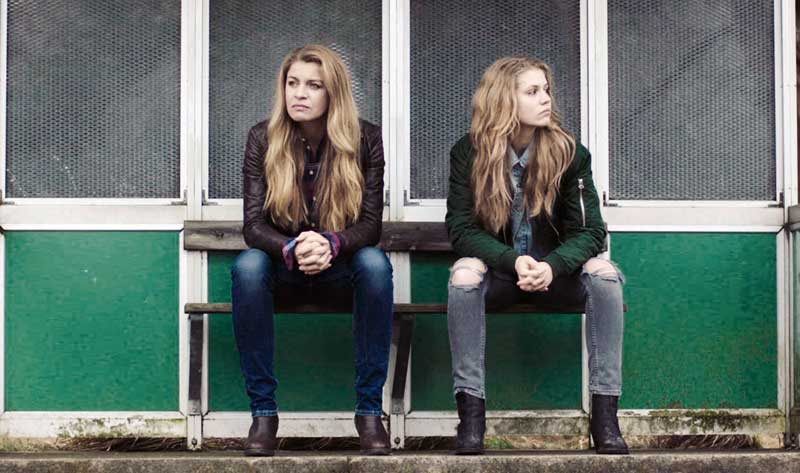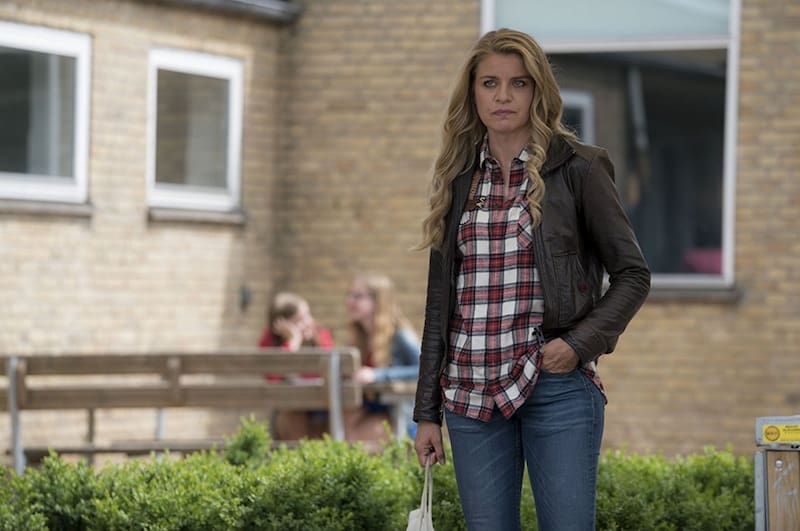Season 4 of Rita, the Danish series created by Christian Torpe, is finally available on Netflix US. It was deeply emotional, heartwarming, and a brilliant resolution to the story of Rita that we have been privileged to see so far.
In season 4, Rita returns to the town where she grew up. She signs on as a teacher at the same school she went to. The school is in danger of closing, but is hiring new teachers. The principal Bjarne (Ole Lemmeke) wants to keep it open. Bjarne says he can fix anything, even a school about to be closed.
Being in her home town brings back memories of her youth for Rita. She’s taken back to 1985, to her first year in the school she’s now entering every day. She’s taken back to the same streets and houses where pivotal events in her life took place.

Mille Dinesen plays Rita. The 1985 Rita was played by Tessa Hoder.
My impression of the two Ritas was that the casting and acting were so skillful you forget that it is two actors playing Rita. She’s one person, consistent in outlook, mannerisms, and personality across her lifetime. Whether it’s 1985 or 2017, Rita is Rita. Good writing, smart directing, and excellent acting from both actors made Rita’s life a seamless whole.
As a fan of Orphan Black, I’ve commented that it’s easy to forget that only one actor plays all the clones. They seem to be completely different people. With season 4 of Rita, it’s the reverse. You forget that two different actors are playing the same character. Mille Dinesen and Tessa Hoder are so convincingly one person. According to IMDb, this is Tessa Hoder’s first acting job. She’s flawless in this role.
The season 4 story
Hjørdis (Lise Baastrup) convinced her husband Uffe (Kristoffer Fabricius) that they should move to the same town as Rita with their infant son. Hjørdis even got a job at the same school as Rita. Rita didn’t appreciate Hjørdis and her efforts to look after her, be a friend, be a support. She often tried to get Hjørdis to leave her alone.
The first problem student Rita dealt with in the new job was Allan (Albert Reffelt Dalum). She went to talk to his parents.
Allan’s mother was Lea (Charlotte Munck as an adult, Sofie Juul Nielsen as a teen). When Rita and Lea saw each other it was a shock to them both. The way they looked at each other screamed past history.

Rita and Lea were best friends in high school. Rita even lived at Lea’s house for a time. Memories of that time often involved Lea. Rita and Lea had an intense relationship as teenage girls. Not quite sexual, but something more than platonic friendship.
At first Lea wanted nothing to do with Rita as an adult. She was angry about the past. But as the episodes rolled by they took up their old friendship.
Their feelings for each other grew intense once again. Not quite sexual although there were a couple of drunken kisses. It was something more than platonic friendship, and important to both of them.
There was lots of evidence in past seasons that Rita is straight. And Lea was married to a man. But I got the impression that if conditions were right they might make an exception for this one particular person.
There were subplots involving the needs of the students and the efforts to keep the school open. Uffe and Hjørdis provided some interesting subplots. Finding a place to live and to call home were themes affecting both Rita and Hjørdis.
Rita and Hjørdis had several confrontations. Most of them were unkind on Rita’s part. She wanted to unlatch Hjørdis from her side so she could spend time with Lea. But I knew by the end of the season, Rita and Hjørdis would mend themselves, and they did.
We know about Rita’s adult life from seasons 1-3. We know about her children, her grandchildren, her marriages, her affairs, her commitment to kids and education. Season 4 fills in gaps from her early life. We see why she is angry about her parents, why she makes her own rules. We might even get a clue about her fondness for plaid shirts.
The constant motif in Rita’s life in past seasons has been bad decisions and irresponsible choices. Being forced to examine her past helped her accept her mistakes – some of which were huge – and forgive herself. Where that leads her in the last episode was a fitting and satisfying conclusion.
This was the best season of Rita ever. I base that statement on the gracefully integrated past and present we saw as Rita reconciled with her life. Switching from one time period to another happened effortlessly. Again I praise the writing and directing and cinematography stitching Rita’s life stages together. The cinematography was beautiful in every way, actually.
Season 4 almost didn’t happen. When season 3 ended it seemed the end. There was lots of noise from fans begging for more. Finally Netflix decided to produce one more season of this popular series. Good decision, Netflix.
The way season 4 ended could be considered the end. Rita was in a good place that made sense for her. Or, should the money people in Denmark and at Netflix decide to give us more, it could be the beginning of a whole new adventure. Personally, I love Rita. I could spend many more years with her.
Most of the episodes were directed by Lars Kaalund. Natasha Arthy directed two episodes of the eight in season 4. Christian Torpe was head writer. Rita was his vision and creation throughout, but several other writers worked on season 4, including some women.
What did you think of season 4?



Leave a Reply